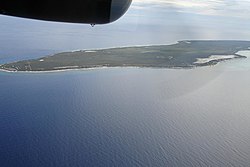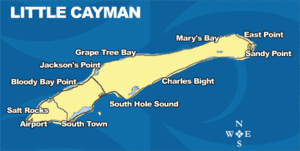Little Cayman
| Little Cayman | |
 Little Cayman from the air | |
|---|---|
| Location | |
| Location: | 19°40’59"N, 80°3’4"W |
| Highest point: | 40 feet |
| Data | |
| Population: | 170 |
Little Cayman is one of three islands comprising the Cayman Islands in the Caribbean Sea; it lies some 60 miles northeast of Grand Cayman and five miles west of Cayman Brac.
Little Cayman is by far the least populous of the thre main islands, with a permanent population of about 170. It is about 10 miles long with an average width of one mile and most of the island is undeveloped. Almost the entire island is at sea level. The highest elevation is about 40 feet.
Little Cayman is known for its excellent scuba diving and bird watching, unspoiled wildlife habitat and laid-back atmosphere.
Despite its small size, the island hosts a heritage festival and parade as part of Pirates Week, the annual Mardi Gras celebration of the Cayman Islands and the Sister Islands Cook-off.[1]
History
The first recorded sighting of Little Cayman, along with Cayman Brac, was by Christopher Columbus on May 10, 1503 on his fourth and final voyage, when heavy winds forced his ship off course. At that time, he named the islands "Las Tortugas" for the many sea turtles found living there. The islands were later renamed "Las Caymanas" for the iguanas living there, which were thought to be caimans.
The first settlement on the island was in the 17th century, when turtle fishermen set up camps. After a raid by a Spanish privateer, the settlements were abandoned in 1671 and the island was not resettled until 1833, when Blossom Village was established by a few families. By the early 20th century, a few hundred people lived on Little Cayman and exported phosphate ore, coconuts, and marine rope.
Attractions

Diving
Little Cayman is famous for its scuba diving. The most popular dive site areas, Bloody Bay and Jackson's Bight, are both located on the north side of the island, just west of its midpoint. The deeper sites on its south side are generally visited on winter days when the north side is too rough. Little Cayman features dive sites as shallow as 20 feet and its walls are deep enough to effectively be infinite.[2]
Bloody Bay in particular is consistently ranked as one of the world's top dive sites. Many dive operations claim the late Philippe Cousteau declared its wall to be one of the three best dives in the world, although this story may be apocryphal. At its shallowest point, the drop-off begins at a depth of 18 feet, allowing divers who plan carefully to achieve maximum depth of over 100 feet but still enjoy exceptionally long dive times. But the wall is so famous primarily because sections of it are so sheer as to be effectively vertical, a rarity.
The most vertical section of the wall (the dive site "Great Wall West") was immortalized in 1999 by the Bloody Bay Wall Mural Project.[3] A crew of photographers directed by Jim Hellemn photographed the wall piece by piece and the images were compiled into a single, highly detailed image of the entire wall. The photograph was reproduced in National Geographic magazine in 2001. In 2010, photographers returned to the same section of wall in an effort to create a comparison image showing changes over the intervening decade.[4]
The depth of Little Cayman's dropoffs is often exaggerated by local divemasters claiming depths of 3,000 feet or 5,000 feet. In truth, the 1000 m contour (3000+ ft) has been charted to be approximately one mile offshore on Little Cayman's south side, and 2.5 miles offshore of Bloody Bay on the island's north side, distances far beyond the areas dived by recreational divers.
Little Cayman's reefs are exceptionally healthy for a regularly dived area and inhabited by a full range of typical Caribbean reef life, from pipehorses to sharks, and including a notable population of sea turtles.
In 2010, local dive operators launched a concerted effort to eradicate the invasive, non-indigenous Red Lionfish Pterois volitans, which appears to be limiting its population around Little Cayman. On Wednesday afternoons, divemasters from the various resorts on Little Cayman embark on Lionfish kills to hunt and cull the species. Since the hunts began, more grey Caribbean reef sharks (Carcharhinus perezii) are noticeable on dives.
Booby Pond and Rookery
Little Cayman's Booby Pond Nature Reserve supports the largest red-footed booby population in the Caribbean and is a designated Ramsar wetland of international importance. The site encompasses 202.6 acres (82.0 ha). The Cayman Islands National Trust building on one edge of the pond offers viewing decks with telescopes, and the building itself is open for a couple of hours on weekday afternoons. It contains exhibits about Little Cayman's flora and fauna, a library and a small selection of gifts. If you are lucky, homemade ice cream will be available for sale.
Iguanas and other Fauna
Little Cayman has the only substantial population (estimated at 1,500) of the critically endangered Lesser Caymans iguana (Cyclura nubila caymanensis). Predation by cats and dogs, encroachment by humans into their habitat and road deaths have reduced their population on Cayman Brac to less than 100. The iguanas are easy to spot on Little Cayman and the National Trust unveiled a boardwalk in December 2013 that allows visitors to view one of their nesting areas.
Little Cayman also hosts the critically endangered hawksbill turtle, and the threatened West Indian Whistling Duck (Dendrocygna arborea), also known as the Black-billed Whistling Duck. The Tarpon Lake, a salt pond near the center of the island, boasts an unusual population of landlocked tarpon, a large silver fish that usually lives only in the ocean.
Owen Island
Owen Island is a small islet off the south-western coast of Little Cayman. The only way to reach it is by boat, and many visitors make the trip using a kayak or standup paddleboard to cross South Hole Sound Lagoon. The islet features no buildings, homes, or human habitation, making it popular for honeymooners and adventurers.[5][6]
Point of Sand
Little Cayman has many rocky beaches suitable for walking or entry points for diving and snorkeling. But the island has only one truly fine swimming beach with an expanse of sand, a clean, sandy bottom and a protective reefline: Point of Sand. Currents are often very strong, but the shallowest areas are suitable for careful wading even by nonswimmers. Point of Sand is located on the northeastern tip of Little Cayman and boasts a clear view of Cayman Brac five miles away. Indeed, the beach is sufficiently lovely that it attracts visitors from Cayman Brac who come over on boats. Sundays, in particular, find many local families using the beach, which is likely to be deserted on weekdays. The beach has a shelter with picnic tables and a barbecue, but no services of any kind and no water. Getting there requires a rented car or scooter; the determined and physically fit can get there on a bicycle.
Kite Surfing and Kayaking
Southern Cross Club, Sunset Cove and Little Cayman Beach Resort provide kayaks for guests. They will usually rent them to non-guests if they aren't too busy.
Kite Surfing is available at Southern Cross Club (as of November 2014). This enterprise had previously been the Lost Boys Kite Surfing School, which had opened in 2011 at Sunset Cove.
Little Cayman Museum
A small collection focusing on local history is open short hours, usually weekday afternoons.
Accessibility and Services
Little Cayman is accessible by air (with Cayman Airways) on daily inter-island flights [7] from both Cayman Brac and Grand Cayman. Little Cayman is not an entry point to the country; visitors and residents must land first at one of the larger islands.
Little Cayman has one grocery-and-hardware store (one competing grocery store may or may not still be open), two liquor stores, one full-service restaurant, one church, a car rental operation and two small souvenir/resortwear shops. It is served by the tiny Edward Bodden Airfield (the airport), a two-man police force, a small fire crew with one truck, a part-time postmaster, a power station operated by Cayman Brac Power and Light, a clinic staffed by a nurse and a one-room school whose enrollment is usually in single digits. Cellular phone service offered by LIME and Digicel has almost completely eliminated reliance on landlines, which many residents maintain primarily to allow them to connect to the Internet, which can only be accessed by ADSL.
Resorts, Restaurants and Bars
Little Cayman Beach Resort[8] is the island's largest enterprise, with 40 rooms and a multi-boat diving operation. Its restaurant (which serves only at set hours) is open to non-guests, as is the bar, which sometimes offers karaoke on Friday nights.
Pirates Point Resort,[9] with 10 rooms, and,[10] with 14 rooms, offer a more personal experience. Each has its own dive boat; Southern Cross also offers fishing trips. Non-guests can make arrangements to dive or eat there but cannot just walk in.
Paradise Villas[11] offers a la carte accommodation next door to the Hungry Iguana, the island's only full service restaurant and bar. They refer guests to other dive operators, typically Conch Club Divers,[12] which services guests of Conch Club Condominiums.[13]
Sunset Cove,[14] offers the most economical rooms on the island and also has an onsite restaurant.
Sam McCoy's no longer operates as a resort, but the Sunset Bar lives on and is the least expensive place to get a drink (lots of locals here). They usually serve homemade barbecue on Saturdays.
Outside links
| ("Wikimedia Commons" has material about Little Cayman) |
References
- ↑ Little Cayman Islands Tourism Official
- ↑ Little Cayman Diving
- ↑ Bloody Bay Wall Mural Project
- ↑ [1]
- ↑ Owen Island Official
- ↑ [2]
- ↑ http://www.caymanislands.ky/planatrip/gettingherebyair.aspx
- ↑ Little Cayman Beach Resort
- ↑ Pirates Point Resort
- ↑ [3] Southern Cross Club
- ↑ Paradise Villas
- ↑ [4]
- ↑ [5],
- ↑ [6] Sunset Cove
